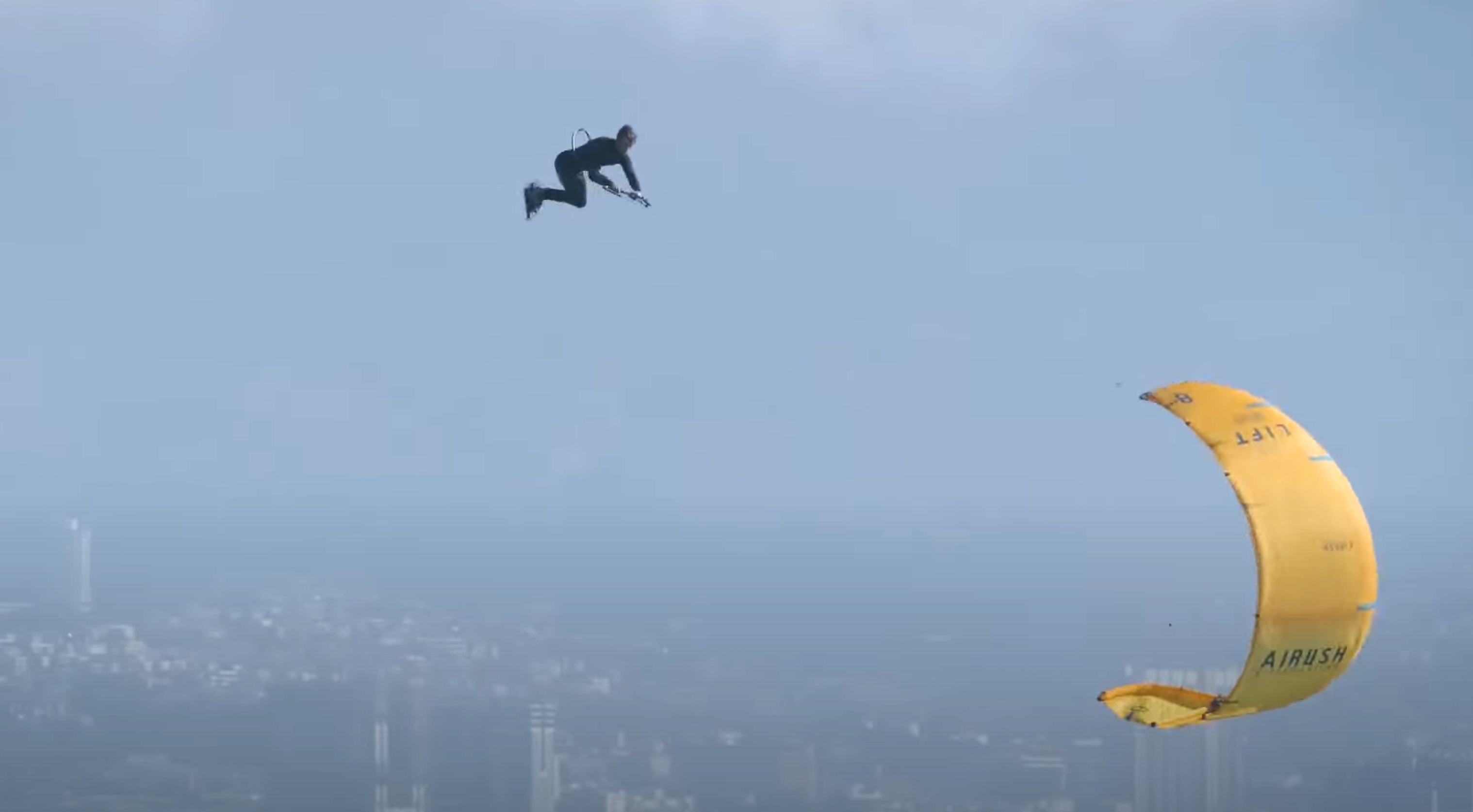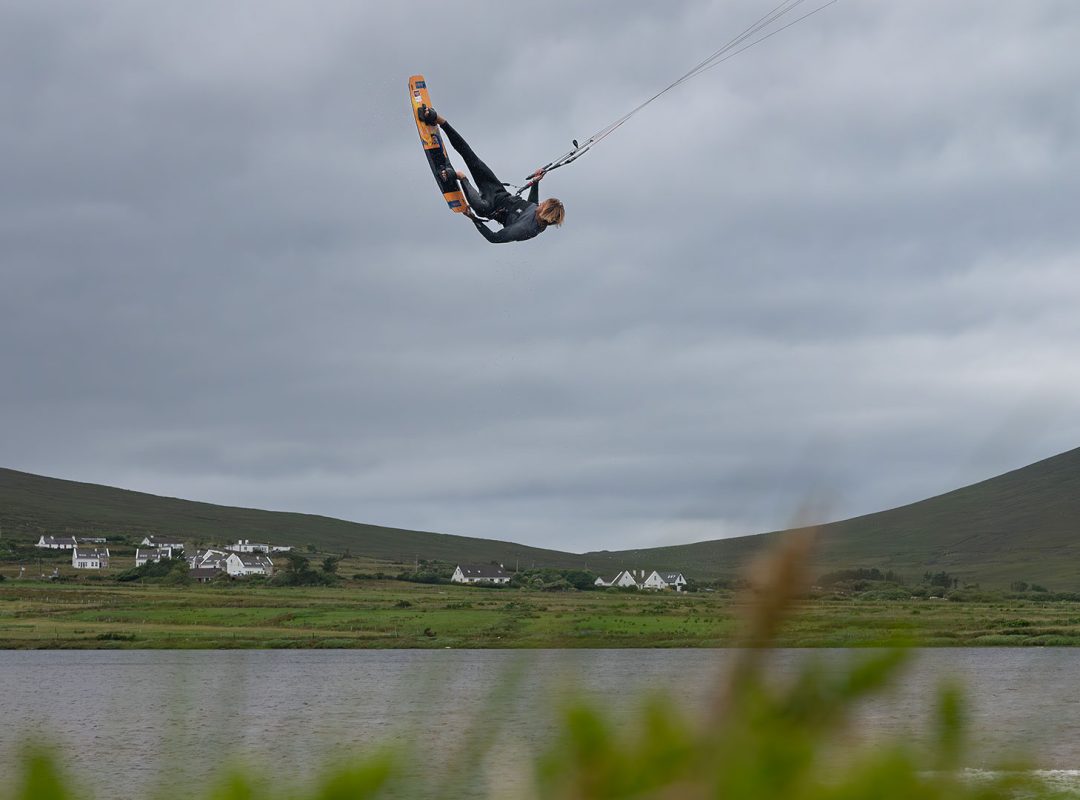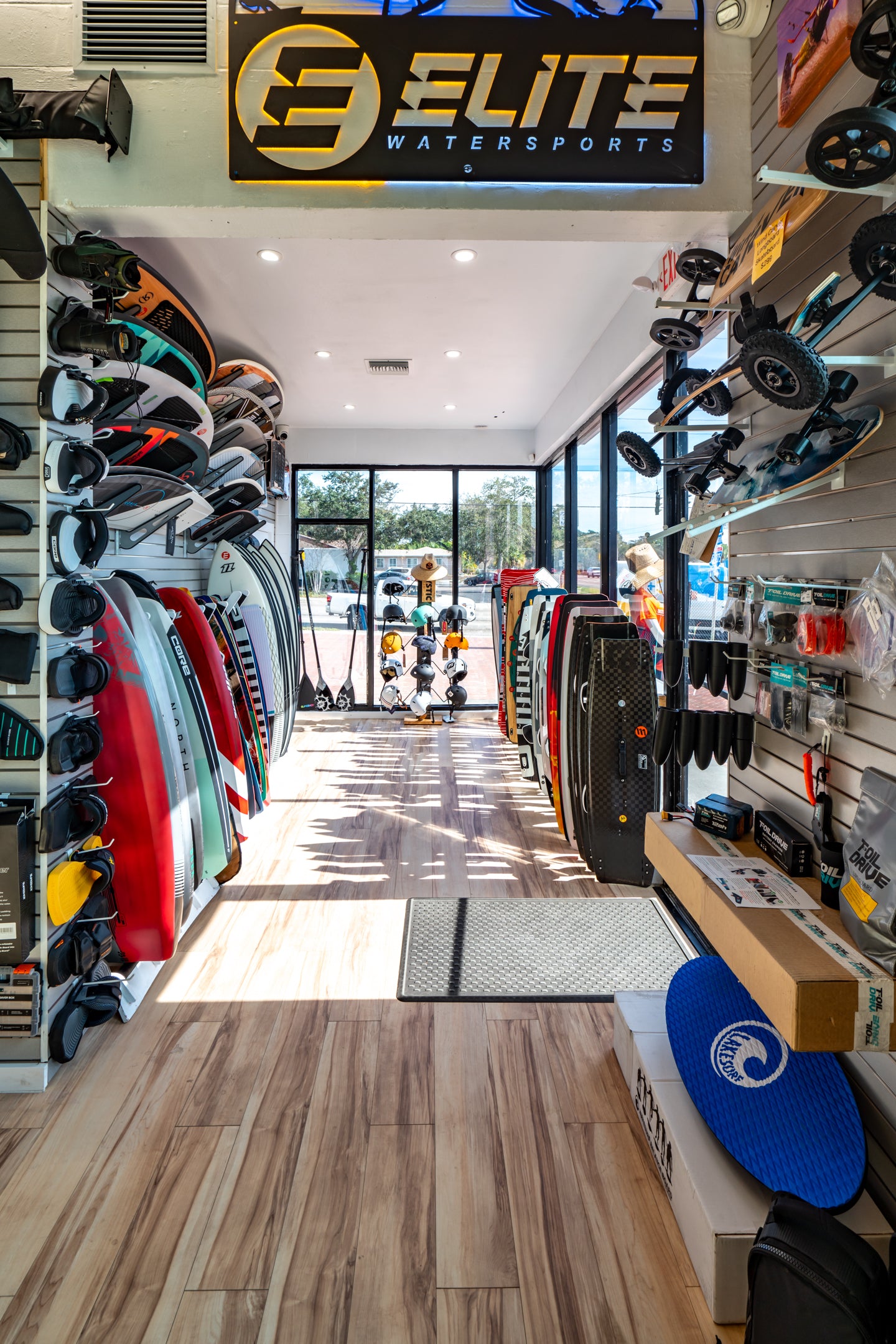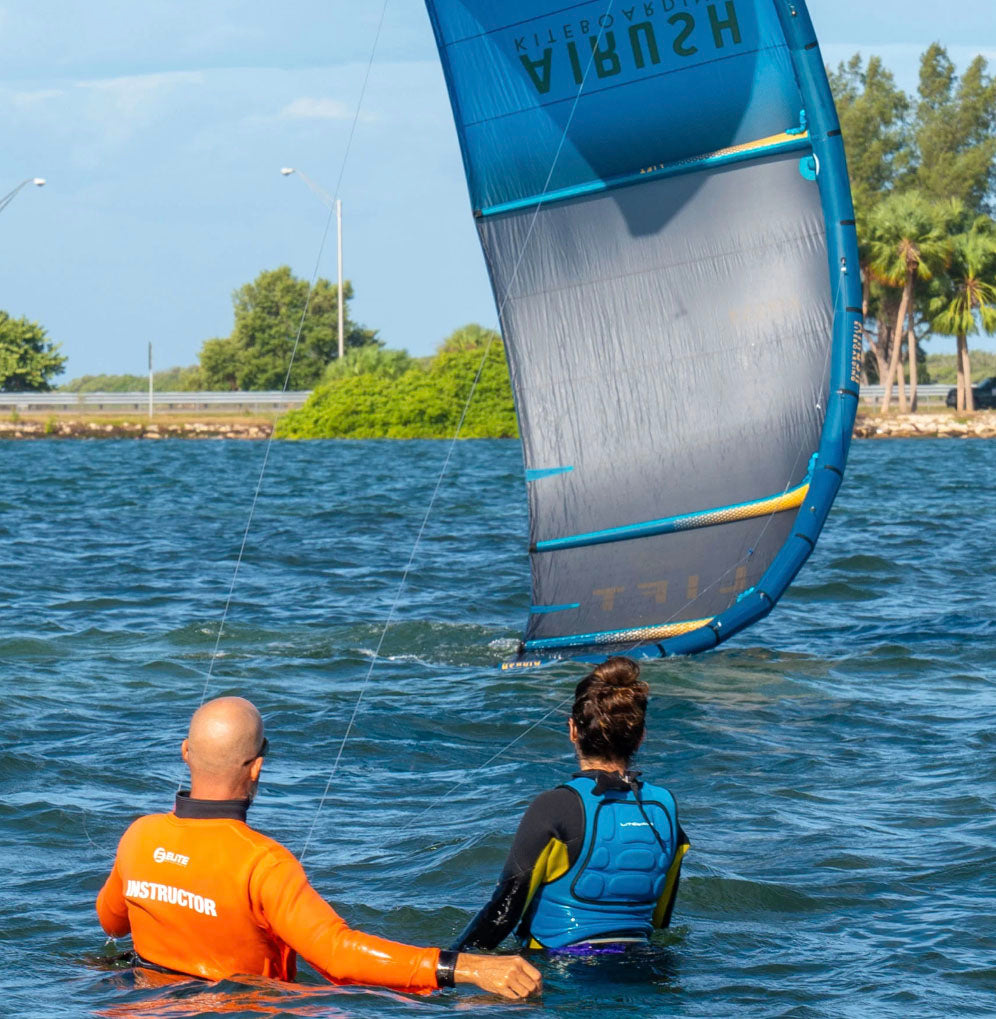ELITE WATERSPORTS
Last updated 9-16-2024
The Best Big Air Kites?
Everything you need to know.

Different styles of big air kites.
When choosing the best kites for big air, it's not about the number of struts or even the brand; it's the model and its design characteristics that count.
When it comes to big air kiteboarding so far, the 5-strut big air kite has reigned supreme. These kites are designed for riders looking to push the limits in either competition or be the standout rider on their local beach.
There is a new school breed of big air kite on the rise, and it is worth considering. Big Air optimized 3-strut all-around kites are on the rise. The Airush Lithium V14 leads the charge with a forgiving, lofty, all-around shape optimized for big air. The bridal geometry is unique and incorporates a stopper ball. It's not a far cry from the 5-strut Airush Lift V3. This means the kite is forgiving in bad, gusty wind and is super lofty.
The V14 loops better with a fast catch. The best part is the loops are forgiving, so it's ideal for riders who want to learn how to kiteloop.
There are generally two types of big air riders: those who prioritize loft to perform tricks like board-offs and those who prefer a kite that loops well, helping them compete at the highest level or dominate their local scene.Both styles require specific attributes from a kite; not all kites are created equal.
There is also a case to build a mixed quiver of kites to cater to your conditions. We'll share insider tips on choosing the best style big air kite for you. The good news is that the market offers plenty of options depending on your riding goals. This blog will help you establish what kind of rider you currently are, where you wish to go, and the right kite style to get you there.




Table Of Content
- 5-Strut Kites vs. 3-Strut Kites for Big Air: What's the Difference?
- What Kind of Big Air Kiter Are You?
- 5-Strut vs. 3-Strut Kites for Big Air
- Building a Quiver with 3-Strut and 5-Strut Kites
5-Strut Kites vs. 3-Strut Kites for Big Air: What's the Difference?
5-Strut Big Air Kites: Optimized to hold down power and get airtime. These kites can be focused on kite loops or hang time. Sometimes, they are good at both, like the Lift V3. Most 5-strut kites perform better when powered up, meaning they have more top end than low end. They shine when you're lit.
3-Strut All-Around kites: Optimised to do everything well. These kites vary wildly in performance. They all do everything well, but some lean toward a specific style more than others. This article is on big air, so we will refer to the Airush Lithium V14 as it's the first of a new breed of big air kite. Expect good low-end performance, more top-end performance, and forgiving kite loops. Compared to a 5-strut kite, the loops will feel far less intimidating, and you'll benefit from the extra loft and ease of use.
Faster progress: For most beginner to intermediate riders, a 3-strut kite is the best option for accelerating progression and boosting confidence in big air. This kite is ideal for anyone who needs the extra loft, providing an accessible and forgiving ride.
Why does this matter? Kites like the Lithium V14 offer maximum hang time and loft, fast, forgiving loops with a smooth catch, making the rider feel in control, even in variable conditions. For those still building their skills, the easy-to-use nature helps you progress quickly without the intimidation factor. Especially when conditions are horrible, these kites don't ask much from the rider, and the added hangtime is essential for progress into board offs.
Progress is the name of the game for beginner and intermediate riders. Choosing a more aggressive kite before you're ready can hold you back or, even worse, discourage you from pushing your limits. A key feature of 3-strut kites like the Airush Lithium V14 is that they are generally lighter, more responsive in low winds, and offer easier handling.
These characteristics are essential for riders with less than three years of experience because they allow for a broader wind range and faster learning. These kites are particularly fun to fly in less-than-ideal wind conditions, where they catch and loop easily.
High Performance: In contrast, 5-strut kites are typically better suited for advanced riders consistently riding in high wind and overpowered conditions. These kites are purpose-built for riders who need extra stability when the wind picks up and want to push their limits with aggressive loops and massive jumps.
5-strut kites thrive in strong wind because the extra struts provide added structural support, allowing them to hold more power and stay stable when overpowered. However, this also means that these kites don't perform as well in underpowered or light-wind conditions, as their design is specifically aimed at handling the intensity of big air.
They also ask for more feedback from the rider. For experienced riders, the ability to hold down more power and throw big loops is where the 5-strut kite shines. While some non-big-air-optimized kites may feel overpowered in high-wind scenarios, the 5-strut kite feels at home, delivering precision and stability.
Loops on a 5-strut kite: are more dynamic, aggressive, and powerful—ideal for riders who want to compete or stand out in big air events. The extra support from the additional struts ensures the kite remains responsive and powerful while loading. The loop will be intense and look and feel more extreme.
The key takeaway is that if you're an intermediate or advanced rider regularly riding in strong winds, a 5-strut kite will offer the best performance for big air. However, if you're still building your skills or ride somewhere with regular wind less than 21 knots, a 3-strut kite like the Airush Lithium V14 will allow you to progress faster, remain playful, and have more fun in a broader range of conditions. When you're ready to upgrade to a 5-strut kite, you'll have the skills and confidence to handle the extra power and intensity.
What Kind of Big Air Kiter Are You?
Big air kiting isn't one-size-fits-all. There are two types of big air riders:
Loft Chasers: Riders who love to float through the air with maximum hang time. For these riders, a 3-strut kite is the go-to option. The lighter feel and smooth loops give you the time and control to focus on perfecting tricks like board-offs and spins while staying airborne longer.
Loop Chasers: Riders who are all about those fast, aggressive kite loops. For them, a 5-strut kite offers the power and stability needed to crank through loops with precision. It's all about pushing the limits in strong winds and getting the most dynamic, powerful loops possible.
What if I want loft and loops? Skill and conditions are key for both. User-friendly competition-level big air kites like the Airush Lift V3 provide more loft, but like all big air 5-strut kites, they require power to shine. Likewise, many 3-strut kites were used to podium in King Of The Air in years past. The Naish Pivot and Airush Lithium are a great example of a 3-Strut big air kite.
Experience matters: Generally, riders with less than three to five years of experience fall into the loft category—they crave that extra height and hang time to practice moves like board-offs, one-footers, and simple loops.
For these riders, having a kite that offers more float allows them to stay in the air longer and build confidence while learning.
Advanced riders: In contrast, more advanced big air riders tend to focus less on hang time and more on power and control in extreme conditions. They rely on powerful kite loops and are often riding overpowered. These riders want precision, dynamic loops, and a kite that holds down serious wind. This kind of riding demands skill and strength, so advanced riders typically gravitate toward the more aggressive performance of 5-strut kites.
What if I want to do it all? The simple answer is to ride an all-around kite! Arguably, 90% of kiters will never max out the potential of their all-around kite.
Want to get better at Big Air? Book a private kite lesson here:
5-Strut vs. 3-Strut Kites for Big Air
5-strut kites may reign supreme for advanced big air riding, there's a strong case for 3-strut kites—especially the new-school, all-around big air models designed for big air progression. One standout example is the Airush Lithium, a kite that perfectly blends ease of use with impressive performance for aspiring big air riders.
The Airush Lithium V14 features a single-point bridle with a stopper ball, which keeps the kite steady and forgiving during loops, making it an ideal choice for riders who want to improve their skills without being overwhelmed by aggressive power. Its design prioritizes smooth, controlled loops and fast recovery, allowing less experienced riders to build confidence in their jumping abilities.
For riders with less than three years of experience, All-around 3-strut kites offer a forgiving and fun learning experience. These kites deliver extra float and are highly user-friendly, which allows riders to progress faster. The forgiving loops make it easier to control the kite in the air, which is essential for learning new tricks without the intimidation of more powerful kites.
On the other hand, 5-strut kites are typically designed for intermediate to advanced riders who need a kite that can handle being overpowered in strong wind conditions. These kites are built to perform when fully powered up, providing stability and control that less experienced riders might find difficult to manage.
The extra support from the additional struts allows these kites to handle more wind, which means they excel in extreme conditions, and consistent power is needed to boost higher and longer.
3-strut kites excel in a wide range of wind conditions, offering a more playful and forgiving ride, 5-strut kites are specialized tools for handling high winds and pushing the limits of big air performance.
The key difference is that 5-strut kites are designed to hold more power and provide extra structural support, which is crucial when riding overpowered. Their loops are more aggressive, making them a favorite for riders looking to stand out or compete in big air events.
For those riders progressing through the beginner and intermediate stages, choosing a 3-strut kite can provide more lift, ease of use, and a more enjoyable experience while honing skills. However, when you're ready to take on strong winds and push the limits of big air riding, a 5-strut kite will offer the performance needed to control powerful kite loops and jump higher than ever before.
If you have any questions or need guidance, please call us at Elite Water Sports at 727-800-2202. We're here to help!
Building a Quiver with 3-Strut and 5-Strut Kites
When putting together your kite quiver, think about the wind where you ride most. If you're lucky enough to get solid, steady winds over 24 knots, a full quiver of 5-strut kites is probably the way to go.
These kites love being powered up and give you that control and stability you need to really boost in strong winds.But if you're in a spot with lighter or more unpredictable winds, mixing it up with some 3-strut and 5-strut kites is your best call.
For your bigger kites, like the 12m or 14m, 3-strut kites are perfect for getting the most out of lighter wind days. They're super easy to handle and give you the extra hang time to stay in the air when the wind's a little iffy.
If you're still dialing in your skills, you might also want to stick with 3-strut kites for your smaller sizes. But for intermediate riders, throwing a 5-strut kite into the mix for your 9m and under will up your game when the wind picks up. Remember, a 5-strut 9m has low-end power similar to an 8m 3-strut, so you're getting a more versatile kite that can handle both mellow and stronger wind days.
This setup gives you the perfect gear for whatever the wind throws your way. You'll be able to work on your skills in lighter winds with the lift and smoothness of a 3-strut while still getting the punchy performance of a 5-strut when the wind's really blowing.
And if you're learning loops, 5-strut kites are a blast even when underpowered—and once you're ready to go big, they absolutely rip when the wind turns on.
If your spot has 20 plus knots: 7m, 9m, 12m, 14m all in 5-struts. Consider a 3-strut for the 14m as the extra low end and light feel will shine in light winds.
If your spot is 20 knots and under regularly: 7m, 8m, 9m kites can be 5-struts for the rare high wind days. 9m, 10m, 12m, 14m could be 3-struts to max out water time and hangtime. You'll notice the 9m size is the line. Use your best judgment based on your location. A 9m 5-strut needs to be powered to perform its best. A 9m 3-strut will have extra grunt for the lulls. Call us if you need help building a custom kiteboarding quiver based on your location, riding style, and specific needs! please call us at Elite Water Sports at 727-800-2202. We're here to help!
Why you should take Kiteboarding Lessons with Elite Watersports.
Elite Watersports has served the Tampa and St Petersburg area for years. They offer kiteboarding and wingsurfing lessons. They also have a retail shop equipt with the latest kitesurfing gear. This is hands down the best location to learn kitesurfing. We have shallow flat water and easy beginner conditions. Call today and reserve your spot for jet-ski-supported lessons. If the wind is blowing, we're going!
If you need help give us a call. .
(727)-800-2202


Author

Ryan "Rygo" Goloversic
Tags
Kiteboarding St Petersburg
Best kites for Big Air
You May Also Like
Want To learn more about kiteboarding?
Follow us to receive the latest update on our journey experience




